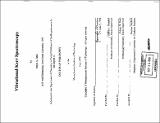Vibrational Kerr spectroscopy
Author(s)
Janni, James A. (James Alan), 1970-
DownloadFull printable version (6.133Mb)
Advisor
Jeffrey I. Steinfeld and Robert W. Field.
Terms of use
Metadata
Show full item recordAbstract
The infrared vibrational Kerr effect was investigated as a potentially selective and sensitive detection method for explosives. The investigation of the vibrational Kerr effect commenced with the first reported measurement of the integrated infrared vapor absorption strengths for the explosives trinitrotoluene, (TNT), cyclotrimethylene trinitramine (RDX), and pentaerythritrol tetranitrate (PETN). From the infrared absorption spectra, the characteristic N02 symmetric and asymmetric stretch bands of the explosives were identified as spectral targets for the vibrational Kerr effect. The vibrational Kerr spectra of fluoroform and nitromethane were successfully measured with conventional Kerr techniques. The vibrational Kerr measurements were first made on the CH stretch-bend combinations of fluoroform around 7000 cm7'. The remainder of the vibrational Kerr measurements were carried out on the N02 asymmetric stretch band of nitromethane at 15 84 nf '. Nitromethane was an ideal test molecule of the infrared measurement system because of its similarity to the eplosives and its large room temperature vapor pressure. Rotationally resolved Kerr spectra of nitromethane were recorded for segments of the asymmetric stretch band and the expected qualitative features of the Kerr spectra were observed. Although the sensitivity needed for the detection of explosives was not demonstrated, the selective detection of polar molecules over weakly polar molecules was demonstrated for a mixture of nitromethane and nitrogen dioxide. The methods investigated for measurement of the Kerr effect in both the infrared and ultraviolet spectral regions are described in detail. Polarization modulation of the light source with phase sensitive detection was expected to increase sensitivity to the Kerr effect over conventional Kerr techniques. Despite the anticipated sensitivity enhancement offered by polarization modulation, poor performance of the photoelastic modulators and the Fourier Transform spectrometer impeded the demonstration of the enhancement
Description
Thesis (Ph.D.)--Massachusetts Institute of Technology, Dept. of Chemistry, 1998. Includes bibliographical references.
Date issued
1998Department
Massachusetts Institute of Technology. Department of ChemistryPublisher
Massachusetts Institute of Technology
Keywords
Chemistry
